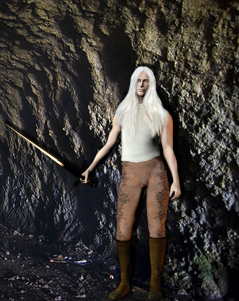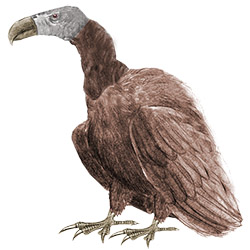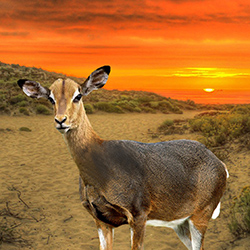Fun Stuff
Dragomeir Species
 The Chosen are the descendents of an ancient race of people that originated from the city of Tadmur, which was located in the country known as Syria. Syria is a country in Western Asia basically bordered by Lebanon and the Mediterranean Sea on the West, Turkey on the North, Iraq on the East, and Jordan on the South. Hundreds of years ago, the Capitol city of Syria, Tadmur, was abandoned due to several reasons, the greatest being an environmental one. Jeremy, the top General of The Chosen, said it was a flooding issue, but there was also an impending war that Syria couldn’t win. The ruling class made it out, but sadly they were about the only ones who did. The ruling class became nomadic and the next hundred years were not kind to them. It was about that time that the first of them contracted Porphyria, and even though they took precautions thinking it was probably airborne, it didn’t do any good. Before they knew what hit them, it was widespread. They believed it was punishment for them abandoning the city, but it was too late to do anything that could potentially regain that loss. They believed themselves to be doomed. To keep it from spreading, they stayed away from any known populace and within a short period of time they were all but forgotten.
Porphyria has several different strains, but all of them are caused by genetic abnormalities and chemically bound to the production of Heme. Heme is a vital molecule found in the liver, bone marrow and most importantly, the blood. In the end they cannot produce plasma or red blood cells, and if not treated, it can be fatal. Other symptoms that are prevalent include pale skin, extended canine teeth, pronounced cranial hair growth and the utter loss of pigmentation. Hence, they have very thick, platinum blond hair and pale blue eyes. The things that don’t show directly are enhanced strength and hyper abilities, such as augmented speed. The muscle tissue over time becomes dense, which makes it more difficult to be harmed by impacts of all sorts. The down side is that they have also become disastrously light sensitive, to the point of rapid burns if out in the sunlight. In short, the Vampire legends were true.
The Chosen are the descendents of an ancient race of people that originated from the city of Tadmur, which was located in the country known as Syria. Syria is a country in Western Asia basically bordered by Lebanon and the Mediterranean Sea on the West, Turkey on the North, Iraq on the East, and Jordan on the South. Hundreds of years ago, the Capitol city of Syria, Tadmur, was abandoned due to several reasons, the greatest being an environmental one. Jeremy, the top General of The Chosen, said it was a flooding issue, but there was also an impending war that Syria couldn’t win. The ruling class made it out, but sadly they were about the only ones who did. The ruling class became nomadic and the next hundred years were not kind to them. It was about that time that the first of them contracted Porphyria, and even though they took precautions thinking it was probably airborne, it didn’t do any good. Before they knew what hit them, it was widespread. They believed it was punishment for them abandoning the city, but it was too late to do anything that could potentially regain that loss. They believed themselves to be doomed. To keep it from spreading, they stayed away from any known populace and within a short period of time they were all but forgotten.
Porphyria has several different strains, but all of them are caused by genetic abnormalities and chemically bound to the production of Heme. Heme is a vital molecule found in the liver, bone marrow and most importantly, the blood. In the end they cannot produce plasma or red blood cells, and if not treated, it can be fatal. Other symptoms that are prevalent include pale skin, extended canine teeth, pronounced cranial hair growth and the utter loss of pigmentation. Hence, they have very thick, platinum blond hair and pale blue eyes. The things that don’t show directly are enhanced strength and hyper abilities, such as augmented speed. The muscle tissue over time becomes dense, which makes it more difficult to be harmed by impacts of all sorts. The down side is that they have also become disastrously light sensitive, to the point of rapid burns if out in the sunlight. In short, the Vampire legends were true.
 The Savants appeared in the Dragomeir Series Book Seven, “Egg of the Amphitere”, and were some of the more unusual visitors to Mt. Drago. They entered Mt. Arcadia first, and impressed with three of the Amphitere Dragons, after having just appeared in the common area. Within minutes they disappeared and went to Mt. Drago to present information to Queen Mother. It was not received well.
The Savants were an ancient race of diminutive people that hailed from Oblivion. Standing only four feet tall and incredibly frail, they had managed to impress with the most violent of the species of dragons, the Amphiteres. The people of Mt. Drago only saw three of this race, all female, although Tanis had a difficult time determining their sex until an introduction was made.
All three of them wore floor length white smocks, were bald, and only spoke by writing their messages on a series of Post it Notes.
Seemingly able to move through both time and space, these unusual females quickly angered Queen Mother into a bold show of power to establish who was in control . . . and who was not.
The leader of the Savants called herself Caesarea Maritima (Also a city in Israel), and although very old, had the body of a child. The other Savants looked identical to Caesarea making it difficult to tell them apart. Their existence in our world was made possible due to the Hearths they controlled, and an underlying hatred for the Dark Lord.
The Savants appeared in the Dragomeir Series Book Seven, “Egg of the Amphitere”, and were some of the more unusual visitors to Mt. Drago. They entered Mt. Arcadia first, and impressed with three of the Amphitere Dragons, after having just appeared in the common area. Within minutes they disappeared and went to Mt. Drago to present information to Queen Mother. It was not received well.
The Savants were an ancient race of diminutive people that hailed from Oblivion. Standing only four feet tall and incredibly frail, they had managed to impress with the most violent of the species of dragons, the Amphiteres. The people of Mt. Drago only saw three of this race, all female, although Tanis had a difficult time determining their sex until an introduction was made.
All three of them wore floor length white smocks, were bald, and only spoke by writing their messages on a series of Post it Notes.
Seemingly able to move through both time and space, these unusual females quickly angered Queen Mother into a bold show of power to establish who was in control . . . and who was not.
The leader of the Savants called herself Caesarea Maritima (Also a city in Israel), and although very old, had the body of a child. The other Savants looked identical to Caesarea making it difficult to tell them apart. Their existence in our world was made possible due to the Hearths they controlled, and an underlying hatred for the Dark Lord.
 The Hell Hounds were initially encountered in Book Five of the Dragomeir Series, “The Emerald Dragon.” These creatures were living at Mt. Drago after making a mass exodus from the Provinces of Hell, with the help of the Queen Mother or “The Ariella.” Inside Mt. Drago, they took up shop in an area of the mountain called Tarin’s Gallery.
The Hell Hounds are a genetically altered species that started off with a considerable amount of wolf and pit bull in their heritage. No one is really sure what else went into the mixture, but what we do know is that they went after size and stamina. The full grown males of this species top over three hundred pounds, stand about five feet tall and can run for days. Their fur is course and sometimes sparse, and they are predominately brown in color with brown eyes. Each one has a different and uneven muzzle, with teeth that protrude in a variety of directions, even with their mouths closed. They also sport an opposing thumb and forefinger.
The Hell Hounds were initially encountered in Book Five of the Dragomeir Series, “The Emerald Dragon.” These creatures were living at Mt. Drago after making a mass exodus from the Provinces of Hell, with the help of the Queen Mother or “The Ariella.” Inside Mt. Drago, they took up shop in an area of the mountain called Tarin’s Gallery.
The Hell Hounds are a genetically altered species that started off with a considerable amount of wolf and pit bull in their heritage. No one is really sure what else went into the mixture, but what we do know is that they went after size and stamina. The full grown males of this species top over three hundred pounds, stand about five feet tall and can run for days. Their fur is course and sometimes sparse, and they are predominately brown in color with brown eyes. Each one has a different and uneven muzzle, with teeth that protrude in a variety of directions, even with their mouths closed. They also sport an opposing thumb and forefinger.
What the Dark Lord of the Provinces didn’t expect was that they were a species on the fast track to sentience. Generations later, they were no longer just guard dogs. Through sheer will, a lot of death and destruction, and the help of a young girl, the Dark Lord’s daughter, they managed to escape.
By the eleventh generation they were not only intelligent, but self aware and very unhappy with the Dark Lord. That’s where “The Ariella” entered the picture and gave them an opportunity they couldn’t ignore – a chance to break away from a life of cruelty, maltreatment and servitude.
The Hell Hounds of today are drastically different than the ones written about in history. The ones in Mt. Drago would rather not fight; they are vegetarians and prefer to stay in one place to rear their children. They are deeply spiritual and have a great sense of humor.
 The Sabers can be found in Book Six of the Dragomeir Series, “Flight of the Aguiva.” They are one of the older races of non-human, quadrupeds and considerably larger than most. Their leader is an enormous Alpha male named Suyet Suun. Try to imagine a nine foot long, eight hundred pound Bengal Tiger in a yellowish gold color, with tusks coming off the side of his face – ten inch long, large tusks. He was at the very least half again the size of a Bengal. Huge feet below a shear muscled body, and topped off with the most regal of heads. That was Suyet Suun. The females of The Sabers are smaller versions but just as beautiful. The Sabers are mammals and give birth in the same way as the feline species we have on Earth.
These creatures are fully sentient, and thanks to the demons on the Provinces, have been placed on the endangered species list. The demons hunt them for sport, or did until they moved to Mt. Drago. They are peaceful, but become warlike when their young are threatened. Fierce fighters, they unfortunately do not have the numbers to fend off the superior volume of the Hordes of Hell.
The Sabers can be found in Book Six of the Dragomeir Series, “Flight of the Aguiva.” They are one of the older races of non-human, quadrupeds and considerably larger than most. Their leader is an enormous Alpha male named Suyet Suun. Try to imagine a nine foot long, eight hundred pound Bengal Tiger in a yellowish gold color, with tusks coming off the side of his face – ten inch long, large tusks. He was at the very least half again the size of a Bengal. Huge feet below a shear muscled body, and topped off with the most regal of heads. That was Suyet Suun. The females of The Sabers are smaller versions but just as beautiful. The Sabers are mammals and give birth in the same way as the feline species we have on Earth.
These creatures are fully sentient, and thanks to the demons on the Provinces, have been placed on the endangered species list. The demons hunt them for sport, or did until they moved to Mt. Drago. They are peaceful, but become warlike when their young are threatened. Fierce fighters, they unfortunately do not have the numbers to fend off the superior volume of the Hordes of Hell.
 The Roc Birds can be found in Book One of the Dragomeir Series, “The Burning Sky.” The Roc birds were the delivery system that caused the phenomenon known as the Burning Sky, which is clearly visible everywhere. That’s important to know if only because it also means they have the ability to fly high enough to achieve rarified air. The pictured Roc has a wingspan of 32.80 feet, or roughly 10 meters, and is not the largest found in documentation. Thankfully, they are not as fast as they are big, a blessing in disguise.
The Roc Birds can be found in Book One of the Dragomeir Series, “The Burning Sky.” The Roc birds were the delivery system that caused the phenomenon known as the Burning Sky, which is clearly visible everywhere. That’s important to know if only because it also means they have the ability to fly high enough to achieve rarified air. The pictured Roc has a wingspan of 32.80 feet, or roughly 10 meters, and is not the largest found in documentation. Thankfully, they are not as fast as they are big, a blessing in disguise.
 The Provincial male Cervos usually weigh 150 to 300 lb. but mature males can weigh up to 400 lb. in the northernmost reaches of their native range, specifically, Hell Proper and Hades.
Although most often thought of as forest animals depending on relatively small openings and ledges, the Provincial Cervos can equally adapt themselves to life in more open prairies and deserts.
The Cervos eat large amounts of food, commonly foraging on other plants, including shoots, leaves, cacti (in deserts), prairie forbs, and grasses. Their diets vary by season according to availability of food sources.
The Provincial male Cervos usually weigh 150 to 300 lb. but mature males can weigh up to 400 lb. in the northernmost reaches of their native range, specifically, Hell Proper and Hades.
Although most often thought of as forest animals depending on relatively small openings and ledges, the Provincial Cervos can equally adapt themselves to life in more open prairies and deserts.
The Cervos eat large amounts of food, commonly foraging on other plants, including shoots, leaves, cacti (in deserts), prairie forbs, and grasses. Their diets vary by season according to availability of food sources.
 The Bubalos are the largest surviving terrestrial animals on the Provinces. They are typical artiodactyl (cloven hooved) ungulates, and are similar in appearance to the earthly buffalo. They are broad and muscular with shaggy coats of medium length hair. Adults grow to approximately (6 ft 6 in. to 11 ft 6 in.) in length and can weigh from approximately 1000 lb. to 2,200 lb.
Bubalos are nomadic grazers and travel in herds. The bulls leave the herds of females at two or three years of age, and join a male herd, which are generally smaller than female herds. Mature bulls rarely travel alone. Towards the end of the solar year, for the reproductive season, the sexes necessarily commingle.
The Bubalos are the largest surviving terrestrial animals on the Provinces. They are typical artiodactyl (cloven hooved) ungulates, and are similar in appearance to the earthly buffalo. They are broad and muscular with shaggy coats of medium length hair. Adults grow to approximately (6 ft 6 in. to 11 ft 6 in.) in length and can weigh from approximately 1000 lb. to 2,200 lb.
Bubalos are nomadic grazers and travel in herds. The bulls leave the herds of females at two or three years of age, and join a male herd, which are generally smaller than female herds. Mature bulls rarely travel alone. Towards the end of the solar year, for the reproductive season, the sexes necessarily commingle.
